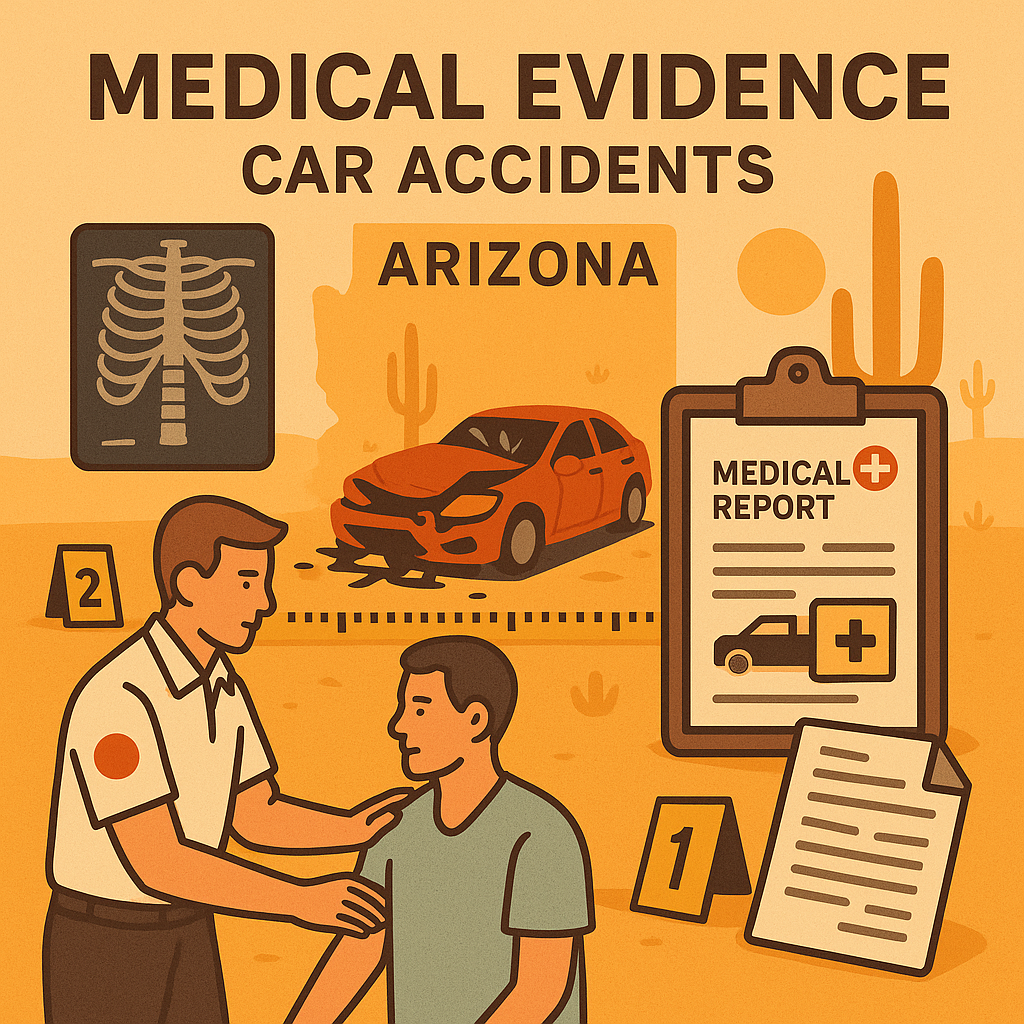When pursuing compensation after a car accident in Arizona, the strength of your case often hinges on one crucial element: medical evidence. Without compelling documentation of your injuries and their connection to the accident, even the most legitimate claims can fall apart. Understanding how to properly collect, preserve, and present medical evidence can make the difference between fair compensation and financial hardship.
Understanding the Importance of Medical Evidence in Arizona Claims
Arizona operates as a fault-based state for car accidents, meaning injured parties must prove another driver’s liability to recover compensation. According to data from the Arizona Department of Transportation, the state sees approximately 130,000 crashes annually, with thousands resulting in serious injuries requiring substantial medical care.
Medical evidence serves several critical functions in your case:
- Establishes the existence and extent of injuries
- Creates a causal link between the accident and your injuries
- Justifies the cost of medical treatment
- Provides objective support for subjective pain claims
- Helps predict future medical needs and expenses
A recent Arizona Republic article highlighted the case of a Phoenix resident who initially declined medical care after what seemed like a minor collision, only to experience debilitating neck pain days later. Without immediate medical documentation connecting these symptoms to the accident, the victim faced significant challenges in securing compensation.
Essential Types of Medical Evidence for Arizona Car Accident Claims
Medical Records and Documentation
The foundation of your medical evidence begins with comprehensive records from healthcare providers. The GLG Arizona injury documentation guide emphasizes collecting:
- Emergency medical services (EMS) reports – Documents your condition at the scene
- Emergency room records – Captures your initial presentation and treatment
- Diagnostic test results – Provides objective evidence of injuries
- Treatment notes from all providers – Establishes ongoing care
- Surgical records – Details invasive procedures required
- Medication records – Shows pain management requirements
Physician Statements and Expert Testimony
Beyond standard medical records, expert medical opinions can substantially strengthen your case by:
- Establishing a clear connection between the accident and your injuries
- Explaining complex medical conditions in terms a jury can understand
- Providing professional opinions on long-term prognosis and future care needs
- Addressing any pre-existing conditions and how the accident may have aggravated them www.mkrfirm.com
Medical Bills and Expenses
Complete documentation of all medical costs provides concrete evidence of your financial damages:
- Hospital and emergency room bills
- Ambulance charges
- Physician and specialist fees
- Physical therapy and rehabilitation costs
- Prescription medication expenses
- Medical equipment purchases
- Home healthcare services
The Evidence Collection Process: Timing is Everything
Immediate Post-Accident Documentation
According to a Phoenix Law Journal report, the first 72 hours after an accident are critical for establishing medical evidence. Victims should:
- Seek immediate medical care – Even if injuries seem minor
- Be thorough and honest with providers – Report all symptoms, no matter how slight
- Explicitly mention the car accident – Ensure records connect injuries to the crash
- Follow all medical recommendations – Treatment compliance strengthens your claim
- Request copies of all documentation – Maintain your own complete record
The Arizona Medical Board notes that medical records must meet specific standards to be considered reliable evidence in legal proceedings.
Common Challenges with Medical Evidence in Arizona Car Accident Cases
Gaps in Treatment
One of the most damaging issues for car accident claims is inconsistent medical care. Insurance companies frequently point to treatment gaps as evidence that injuries aren’t serious or weren’t caused by the accident
As highlighted by attorneys at GLG Arizona’s accident claim center, maintaining consistent treatment creates a chronological record that strengthens the causal connection between the accident and your injuries.
Pre-existing Conditions
Insurance companies often attempt to attribute current symptoms to pre-existing conditions rather than the accident. The East Valley Tribune recently reported on a case where a Phoenix driver with a pre-existing back condition had his claim initially denied despite significant accident-related aggravation.
Effective medical evidence must clearly distinguish between:
- Previous conditions and their stability before the accident
- New injuries directly caused by the crash
- Pre-existing conditions worsened by the accident
Independent Medical Examinations (IMEs)
Insurance companies frequently require claimants to undergo examinations by their selected doctors. According to GLG Arizona’s insurance tactics guide, these examinations often result in opinions that minimize injuries or dispute their connection to the accident.
Preparing for an IME by:
- Reviewing your medical history beforehand
- Being consistent with your symptoms and limitations
- Avoiding exaggeration while being thorough about all symptoms
- Considering having your attorney present during the examination
Practical Strategies for Strengthening Medical Evidence
Maintain a Detailed Symptom Journal
Document your daily experience with injuries by recording:
- Pain levels on a scale of 1-10
- Specific activities limited by your injuries
- Medication usage and effectiveness
- Sleep disruptions
- Emotional impacts of your injuries
Photographic Documentation
Visual evidence can powerfully supplement medical records:
- Photograph visible injuries such as bruises, lacerations, and swelling
- Document casts, braces, or other medical devices
- Take photos showing how injuries affect daily activities
- Use time-stamped images to show injury progression
Gather Witness Statements About Your Condition
Statements from people who can verify your condition and limitations add credibility:
- Family members who observe your daily struggles
- Co-workers who notice changes in your work performance
- Friends who can compare your pre and post-accident activities
The Impact of Arizona’s Comparative Negligence on Medical Evidence
Arizona follows a “pure comparative negligence” system, which allows injured parties to recover damages even if they are partially at fault for the accident. However, compensation is reduced by the percentage of your responsibility.
Strong medical evidence becomes even more critical in comparative negligence cases, as it helps establish:
- The full extent of your damages before any reduction
- That your injuries were primarily caused by the accident, not your actions
- The objective impact of your injuries regardless of fault allocation
Real-World Examples: How Medical Evidence Made the Difference
Case Study: Delayed Symptom Onset
A Scottsdale resident involved in what appeared to be a minor rear-end collision experienced concussion symptoms three days after the crash. By seeking medical care immediately when symptoms appeared and having a neurologist explicitly document the connection to the accident, the victim secured a settlement that covered extensive cognitive rehabilitation.
Case Study: Pre-existing Condition Aggravation
A Tempe driver with documented arthritis experienced significant worsening after a T-bone collision. By providing medical records showing stable management of the condition for years before the accident, along with specialist testimony about the crash’s impact on accelerating symptoms, the victim successfully countered the insurance company’s pre-existing condition defense.
Taking Action: Essential Steps After an Arizona Car Accident
- Seek immediate medical attention – Even if injuries seem minor
- Tell your doctor about the accident – Ensure medical records connect injuries to the crash
- Follow all treatment plans – Consistent compliance strengthens your claim
- Keep detailed records – Organize all medical documents, bills, and correspondence
- Consider legal representation – An experienced attorney can help gather and present medical evidence effectively
The Future of Medical Evidence in Arizona Claims
According to the Arizona Judicial Branch, technological advances are changing how medical evidence is collected and presented in court. Innovations include:
- Electronic medical records with improved documentation capabilities
- Wearable devices that track physical limitations and recovery progress
- Advanced diagnostic imaging showing injuries previously difficult to document
- Telemedicine records becoming increasingly accepted as evidence
Conclusion: The Vital Connection Between Medical Evidence and Claim Success
Comprehensive, well-documented medical evidence forms the backbone of successful car accident claims in Arizona. By understanding what evidence to collect, how to maintain it, and how to effectively present it, accident victims can significantly improve their chances of receiving fair compensation.
If you’ve been injured in an Arizona car accident, don’t navigate this complex process alone. The experienced attorneys at GLG Arizona specialize in helping victims document and prove their injuries to secure maximum compensation. Visit their website today to learn more about their approach to gathering and utilizing medical evidence in car accident claims.



